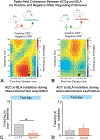Amygdala connectivity and implications for social cognition and disorders
- PMID: 35964984
- PMCID: PMC9436700
- DOI: 10.1016/B978-0-12-823493-8.00017-1
Amygdala connectivity and implications for social cognition and disorders
Abstract
The amygdala is a hub of subcortical region that is crucial in a wide array of affective and motivation-related behaviors. While early research contributed significantly to our understanding of this region's extensive connections to other subcortical and cortical regions, recent methodological advances have enabled researchers to better understand the details of these circuits and their behavioral contributions. Much of this work has focused specifically on investigating the role of amygdala circuits in social cognition. In this chapter, we review both long-standing knowledge and novel research on the amygdala's structure, function, and involvement in social cognition. We focus specifically on the amygdala's circuits with the medial prefrontal cortex, the orbitofrontal cortex, and the hippocampus, as these regions share extensive anatomic and functional connections with the amygdala. Furthermore, we discuss how dysfunction in the amygdala may contribute to social deficits in clinical disorders including autism spectrum disorder, social anxiety disorder, and Williams syndrome. We conclude that social functions mediated by the amygdala are orchestrated through multiple intricate interactions between the amygdala and its interconnected brain regions, endorsing the importance of understanding the amygdala from network perspectives.
Keywords: Amygdala; Anatomic connectivity; Functional connectivity; Network; Nonhuman primates; Social behavior; Social dysfunction.
Copyright © 2022 Elsevier B.V. All rights reserved.
Conflict of interest statement
Competing financial interests The authors declare no competing financial interests.
Figures





Similar articles
-
Attenuated link between the medial prefrontal cortex and the amygdala in children with autism spectrum disorder: Evidence from effective connectivity within the "social brain".Prog Neuropsychopharmacol Biol Psychiatry. 2021 Dec 20;111:110147. doi: 10.1016/j.pnpbp.2020.110147. Epub 2020 Oct 21. Prog Neuropsychopharmacol Biol Psychiatry. 2021. PMID: 33096157
-
Reduced Amygdala-Prefrontal Functional Connectivity in Children With Autism Spectrum Disorder and Co-occurring Disruptive Behavior.Biol Psychiatry Cogn Neurosci Neuroimaging. 2019 Dec;4(12):1031-1041. doi: 10.1016/j.bpsc.2019.01.009. Epub 2019 Feb 4. Biol Psychiatry Cogn Neurosci Neuroimaging. 2019. PMID: 30979647 Free PMC article.
-
Olfactory modulation of the medial prefrontal cortex circuitry: Implications for social cognition.Semin Cell Dev Biol. 2022 Sep;129:31-39. doi: 10.1016/j.semcdb.2021.03.022. Epub 2021 May 9. Semin Cell Dev Biol. 2022. PMID: 33975755 Free PMC article. Review.
-
Amygdala Represents Diverse Forms of Intangible Knowledge, That Illuminate Social Processing and Major Clinical Disorders.Front Hum Neurosci. 2018 Aug 22;12:336. doi: 10.3389/fnhum.2018.00336. eCollection 2018. Front Hum Neurosci. 2018. PMID: 30186129 Free PMC article.
-
Prefrontal circuits guiding social preference: Implications in autism spectrum disorder.Neurosci Biobehav Rev. 2022 Oct;141:104803. doi: 10.1016/j.neubiorev.2022.104803. Epub 2022 Jul 29. Neurosci Biobehav Rev. 2022. PMID: 35908593 Free PMC article. Review.
Cited by
-
Botulinum Toxin A Therapy for Glabellar Lines Improves Emotional States: Evaluation of 47 Cases without Mental Disorders.J Plast Reconstr Surg. 2024 Nov 8;4(2):75-80. doi: 10.53045/jprs.2023-0057. eCollection 2025 Apr 27. J Plast Reconstr Surg. 2024. PMID: 40657169 Free PMC article.
-
Microglia maintain structural integrity during fetal brain morphogenesis.Cell. 2024 Feb 15;187(4):962-980.e19. doi: 10.1016/j.cell.2024.01.012. Epub 2024 Feb 2. Cell. 2024. PMID: 38309258 Free PMC article.
-
Locus coeruleus features are linked to vagus nerve stimulation response in drug-resistant epilepsy.Front Neurosci. 2024 Feb 13;18:1296161. doi: 10.3389/fnins.2024.1296161. eCollection 2024. Front Neurosci. 2024. PMID: 38469571 Free PMC article.
-
Early-in-life isoflurane exposure alters resting-state functional connectivity in juvenile non-human primates.Br J Anaesth. 2023 Dec;131(6):1030-1042. doi: 10.1016/j.bja.2023.07.031. Epub 2023 Sep 14. Br J Anaesth. 2023. PMID: 37714750 Free PMC article.
-
A systematic review on the bidirectional relationship between trauma-related psychopathology and reproductive aging.J Mood Anxiety Disord. 2024 Dec;8:100082. doi: 10.1016/j.xjmad.2024.100082. Epub 2024 Aug 29. J Mood Anxiety Disord. 2024. PMID: 39803367 Free PMC article.
References
-
- Adolphs R, Tranel D & Damasio AR (1998). The human amygdala in social judgment. Nature 393: 470–474. - PubMed
-
- Adolphs R, Tranel D, Damasio H, et al. (1994). Impaired recognition of emotion in facial expressions following bilateral damage to the human amygdala. Nature 372: 669–672. - PubMed
-
- Allison T, Puce A & McCarthy G (2000). Social perception from visual cues: Role of the STS region. Trends in Cognitive Sciences. - PubMed
Publication types
MeSH terms
Grants and funding
LinkOut - more resources
Full Text Sources
Medical

